Two years ago I mulched over the back lawn. It was looking increasingly awful with the prolonged drought, and mulching was an easy project. It required only some compost, wood chips, and builder’s paper.
The photo below shows the lawn struggling with less water.
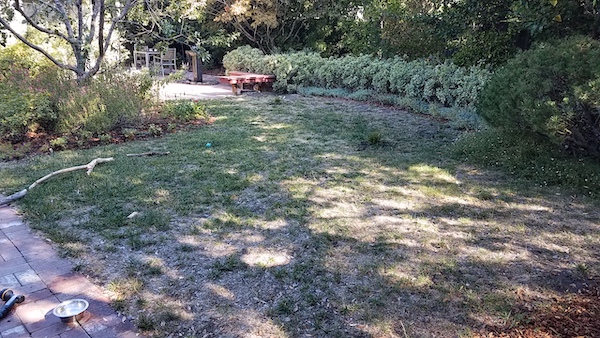
The first step to mulching over it was to spread on some compost, which I picked up for free from the Eleanor Pardee Community Garden.
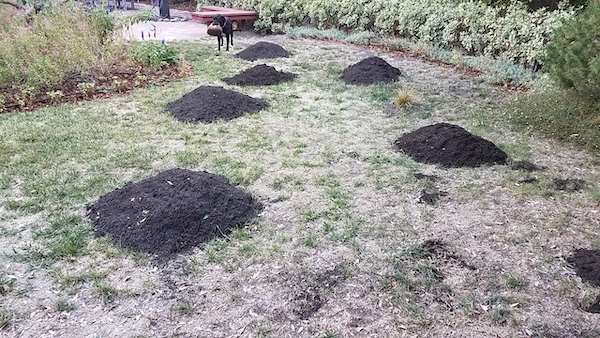
I bought a few rolls of builder’s paper, then my gardener and I laid them over the compost.
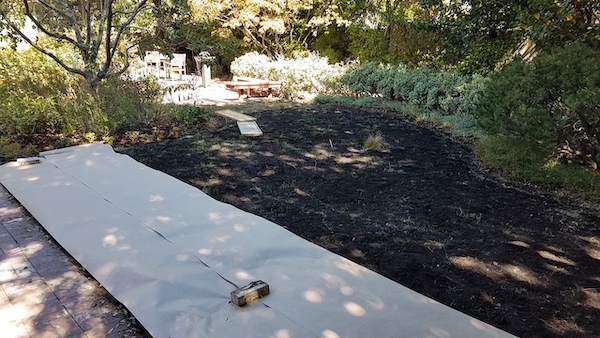
It didn’t take long to cover the whole area.
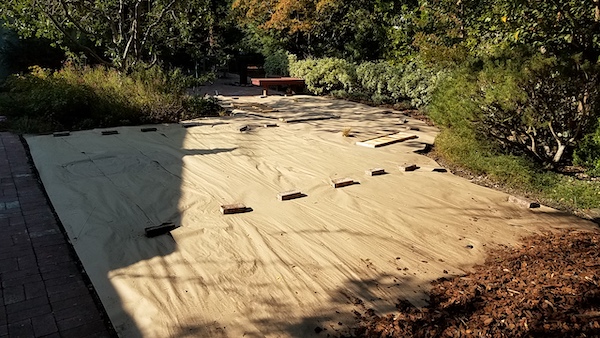
I got some mulch dropped off for free by a local arborist and covered the papered area with it, then watered thoroughly.
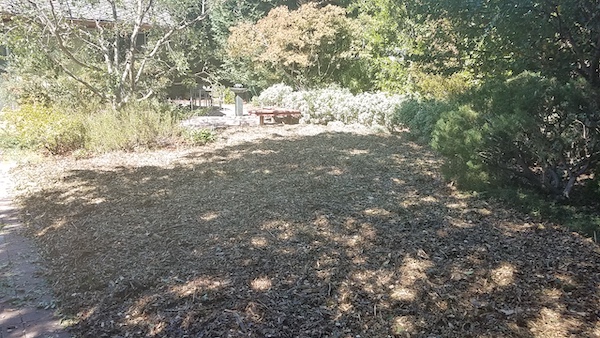
I thought it looked pretty good and got quite used to it. The dog missed the grass more than anyone else.

But I knew that eventually I would plant it with (mostly) natives with the goal of providing more habitat and using less water.
This winter I called a landscape designer who’s done good work in my neighborhood and asked if she would help plant the mulched area. She declined, saying the project wasn’t big enough. I was disappointed, so I put it on hold and kept talking with various people about it. My gardener suggested replacing the existing spray irrigation with inline drip, which would work better for native shrubs. My arborist suggested adding a hose bib or two. I thought I could remove the low hedge near the back to open up the space and create more room for planting. It would also be nice to add a fountain somewhere in the middle.
Then I realized that I could create a lot more planting space if I removed much of the brick and instead put in a few paver pathways. I could reuse some of the brick to make a small patio on the side, where I might rent out a room. I could also shrink the main patio a little to make more space on either side for planting. That would be great.
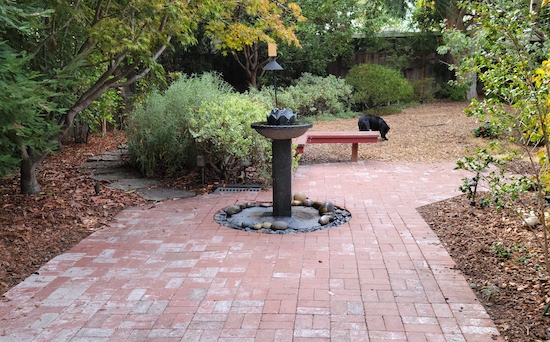
I could remove much of the brick, for example around the existing fountain, as well as the low hedge, to create a lot more planted area.
So I called the landscape designer again and described this bigger project, and she said she could probably do it. She suggested replacing the tile on the patio with stone, as the tile didn’t look great and it was slippery when it rained. The landscape designer also suggested making one brick area slightly bigger in order to better fit a table. Fine, there was plenty of brick to reuse.
I was happy with this plan. The yard would be filled with native plants. The brick would be reused or given away. The patio furniture would all be reused, nothing new. The wildlife would have native plants and a couple of fountains. The tenant would have a nice private patio. And I would have very efficient irrigation. This seemed like a lovely project, low-impact with a great result.
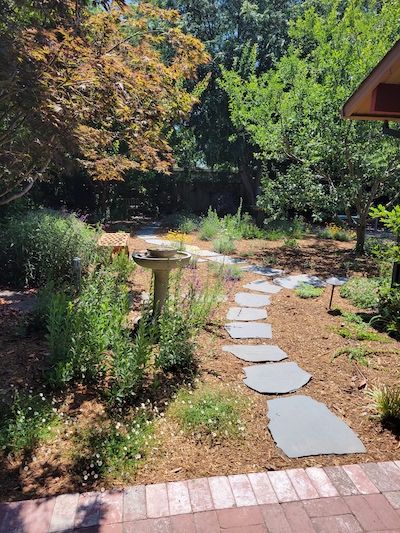
Pavers and native plants replaced brick and a mulched lawn.
But in reality it was not a low-impact project. It’s interesting to think about how that happened and what that means in general.
First the concrete guys came. Since the back patio was put in just twelve years ago, my hope was to chip off the tiles and replace it with stone. But the hardscape lead really didn’t want to do that. He had concerns about the height of the step, and I think generally didn’t want to do a project with a lot of chipping and scraping. So his crew jackhammered the new-ish patio, landfilled the whole thing, and poured a new foundation for the patio just like the old one but a little narrower. They also poured concrete frames under the edges of the new brick areas, which I wasn’t expecting. (My previous brick was set in sand with only a minimal concrete rim on the surface.)
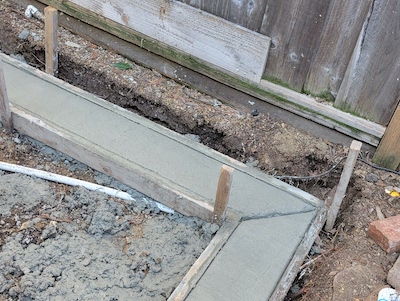
Concrete was poured where the brick edges would go.
The landscape designer asked me to visit a place to pick out stone. I liked a gray one that would match the existing pavers and go with the house colors.
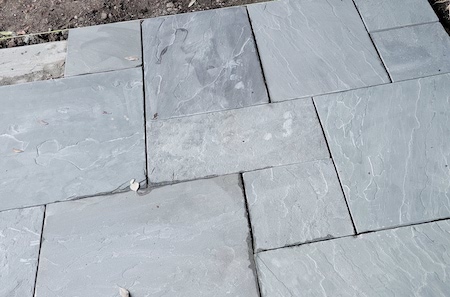
It turns out that the “Select Bluestone” is in high demand. It is quarried on the east coast and then shipped across the country.
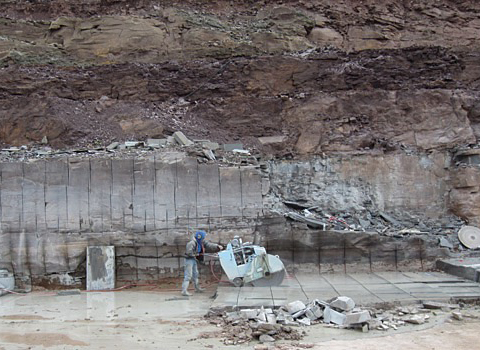
Bluestone is quarried on the east coast and then shipped out here. Image source: Stone World, showing the Endless Mountain Stone Quarry in Pennsylvania.
The low-impact project that I wanted and was expecting was not what happened. Instead of reusing nearly all of the back patio, I demolished the whole thing and poured a brand new one, then topped it with fresh stone shipped all the way across the country. For extra credit, even more concrete was poured to go under the brick. Yikes.
But the waste didn't end there. In order to make one brick area a little bigger to better accommodate a table, the workers had to remove an irrigation valve box. That would require putting in new valves and then adding irrigation to connect them to the main system. Not a big deal, but that’s not what happened. Instead, the landscaper put in a whole new irrigation backbone. I’m still not sure why he did that. Partly it was to support the new hose bibs. But he could have hooked those up to the existing irrigation main lines, which were working fine. He mentioned that he didn’t have a plan and didn’t want to dig around looking for existing lines, which were pretty buried. So now the backyard has two sets of buried irrigation mains. Ugh.
The surface irrigation was a mix of spray and drip, some of which worked well, some not so much. I figured we might as well replace it all with inline drip, which I’d heard was great for plants. But it was a much bigger job than I anticipated, and we ended up putting in many rolls of drip irrigation, along with stakes, plastic fittings, etc. The two fountains I already had I reused (in new places), but a third was needed, so after visiting local places and not finding exactly what I wanted, I pointed and clicked and had a heavy cast concrete fountain shipped from the east coast.
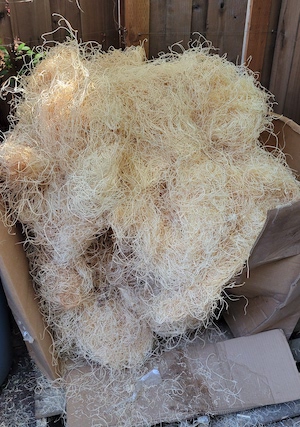
The new fountain shipped in “wood wool” packing material. That was nice, but it would have been even better had I omitted the shipping altogether.
The pile of things that my landscaper hauled away every few weeks -- chunks of concrete, old irrigation, a big plastic fountain basin, old hoses, an old bench, stone scraps, …. How could all of that come out of a simple yard project? I just wanted to plant a few natives…
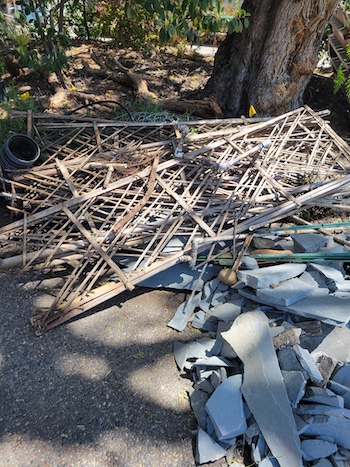
My landscaper hauled away a lot of waste.
I thought about this for a while and came up with a few things.
1. I could have kept the project small but I didn’t. Doing so would probably have required me to do more of the work myself and to make more of my own choices. In my rush to delegate, the scope grew.
2. It is hard to distinguish between high-impact and low-impact products, especially when it’s online. It’s just point-and-click and you’re done, and that is by design. I was not mindful enough about the impact of my purchases.
3. Contractors prefer bigger jobs to smaller jobs. That makes sense, but it doesn’t align well with a more minimal, “reuse and repair” customer.
4. It is often easier and faster to install new than to repair or modify old. Contractors seem to prefer installing new, perhaps because it has a more predictable timeframe, cost, and outcome. For me, it took a lot more time to find people who wanted to come and reuse the brick and then coordinate that than it would have taken to just haul the brick out. Same with cleaning the old fountain stones vs purchasing new, disposing of the planting pots, etc. Because it can take longer and in some cases take more skill to repair and reuse, it can even cost more vs buying new.
5. As a consumer and client, I failed to insist on a more conservative approach. I could have, but I did not because I wasn’t confident enough and didn’t know what my options were. Are there sources for local flagstone? Used flagstone? Probably, but I didn’t think to look and wasn’t pointed in that direction. Could I have insisted on reusing existing irrigation? Of course. But I didn’t know I had to. Same with concrete poured under the edges of the brick.
6. I wanted things to look nice. There’s nothing wrong with that, but because the impact that goes into the finished product is invisible, it is easy to ignore. If I had to store all of the trash on site, I for sure would have done things very differently and the contractors would have been 100% behind me on that.
Some things worked well. Many people were eager to reuse the brick, as well as the plastic pots the plants came in. The old fountains work great in their new places. I managed to repair a hose or two and reuse them. The new plants look terrific and the irrigation works very well. The backyard looks lovely and the birds and pollinators are enjoying it.

The backyard looks natural and sustainable. But …
But looks can be deceiving. I don’t see any way in which this can be considered a sustainable project. The new yard looks and feels wonderful and it is great for some local wildlife. But is it a net win for the planet? Hardly. Yet that seems to be the default way of doing things around here unless we push back hard.
In retrospect, what might have worked better?
Honestly, it might have been better to just use a little more water during the drought, have things look a little nicer, and forego the entire project. Or I could have just chosen and planted some natives in the mulched area on my own, with a simple hand-filled bird bath.
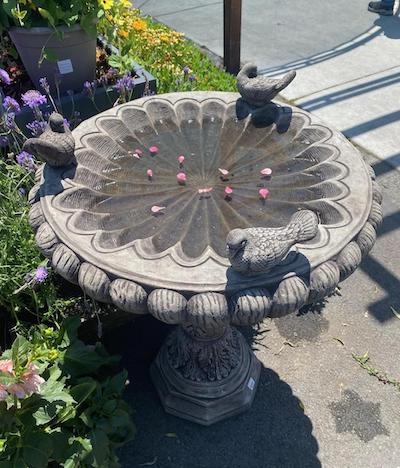
SummerWinds has a nice selection of bird baths that require no installation. Photo credit: Emma Listgarten
It’s possible I could have done with a lot less irrigation and a lot more hand-watering, as my neighbors have chosen to do. Eventually the natives would do okay with little additional water. (That said, my neighbors are looking to put in more irrigation so they can go on vacation without worrying.)
I could have chosen a landscaper who focused on sustainability and would have encouraged me to do these things. Or I could have insisted on more conservative options with the people that I did use. I think they would have accommodated me as long as they could pass on any additional cost.
Even with good intentions, I messed up. Some of that was laziness, or inexperience, or being in a rush. But in general, as long as it is so easy and inexpensive to buy new things, and so easy and inexpensive to throw things away, it’s hard to imagine how we will focus more on reduce and reuse. When impact remains largely invisible, it is hard to make low-impact choices. I really like my yard now, but what does the planet think of it? Worse, my landscaper observed that when someone else moves in, they will redo it all. “That’s just what happens,” he said.
I’d be interested to hear your thoughts on how to keep yard projects truly sustainable, on how we can make it easier to repair and reuse, on how we can encourage lower-impact consumption.
Notes and References
1. One bright spot occurred to me the other day when I saw Amazon actively promoting a used item. Below is an example from a search result for a small induction cooktop. If we can make finding and purchasing used items as convenient as new, then that's a step in the right direction.
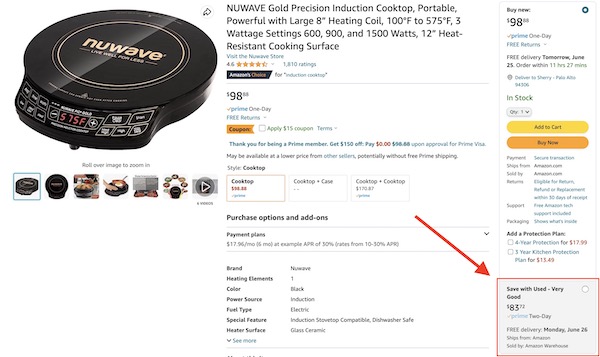
Current Climate Data (May 2023)
Global impacts, US impacts, CO2 metric, Climate dashboard
Earth had its third warmest May ever last month.
Comment Guidelines
I hope that your contributions will be an important part of this blog. To keep the discussion productive, please adhere to these guidelines or your comment may be edited or removed.
- Avoid disrespectful, disparaging, snide, angry, or ad hominem comments.
- Stay fact-based and refer to reputable sources.
- Stay on topic.
- In general, maintain this as a welcoming space for all readers.



